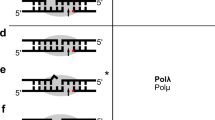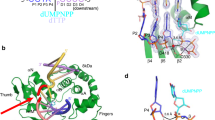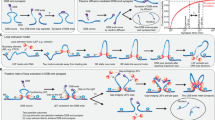Abstract
The double-strand break (DSB) repair pathway called microhomology-mediated end-joining (MMEJ) is thought to be dependent on DNA polymerase theta (Polθ) and occur independently of nonhomologous end-joining (NHEJ) factors. An unresolved question is whether MMEJ is facilitated by a single Polθ-mediated end-joining pathway or consists of additional undiscovered pathways. We find that human X-family Polλ, which functions in NHEJ, additionally exhibits robust MMEJ activity like Polθ. Polλ promotes MMEJ in mammalian cells independently of essential NHEJ factors LIG4/XRCC4 and Polθ, which reveals a distinct Polλ-dependent MMEJ mechanism. X-ray crystallography employing in situ photo-induced DSB formation captured Polλ in the act of stabilizing a microhomology-mediated DNA synapse with incoming nucleotide at 2.0 Å resolution and reveals how Polλ performs replication across a DNA synapse joined by minimal base-pairing. Last, we find that Polλ is semisynthetic lethal with BRCA1 and BRCA2. Together, these studies indicate Polλ MMEJ as a distinct DSB repair mechanism.
This is a preview of subscription content, access via your institution
Access options
Access Nature and 54 other Nature Portfolio journals
Get Nature+, our best-value online-access subscription
$29.99 / 30 days
cancel any time
Subscribe to this journal
Receive 12 print issues and online access
$189.00 per year
only $15.75 per issue
Buy this article
- Purchase on Springer Link
- Instant access to full article PDF
Prices may be subject to local taxes which are calculated during checkout




Similar content being viewed by others
Data availability
X-ray crystallography structure of Polλ with microhomology-mediated DNA synapse was deposited with protein data bank under accession code PDB 7UN7. Source data are provided with this paper.
Change history
14 April 2023
A Correction to this paper has been published: https://doi.org/10.1038/s41594-023-00993-x
References
Moynahan, M. E. & Jasin, M. Mitotic homologous recombination maintains genomic stability and suppresses tumorigenesis. Nat. Rev. Mol. Cell Biol. 11, 196–207 (2010).
Zhao, B., Rothenberg, E., Ramsden, D. A. & Lieber, M. R. The molecular basis and disease relevance of non-homologous DNA end joining. Nat. Rev. Mol. Cell Biol. 21, 765–781 (2020).
Bennardo, N., Cheng, A., Huang, N. & Stark, J. M. Alternative-NHEJ is a mechanistically distinct pathway of mammalian chromosome break repair. PLoS Genet. 4, e1000110 (2008).
Yan, C. T. et al. IgH class switching and translocations use a robust non-classical end-joining pathway. Nature 449, 478–482 (2007).
Boboila, C. et al. Alternative end-joining catalyzes robust IgH locus deletions and translocations in the combined absence of ligase 4 and Ku70. Proc. Natl Acad. Sci. USA 107, 3034–3039 (2010).
Mateos-Gomez, P. A. et al. Mammalian polymerase θ promotes alternative NHEJ and suppresses recombination. Nature 518, 254–257 (2015).
Yousefzadeh, M. J. et al. Mechanism of suppression of chromosomal instability by DNA polymerase POLQ. PLoS Genet. 10, e1004654 (2014).
Koole, W. et al. A polymerase θ-dependent repair pathway suppresses extensive genomic instability at endogenous G4 DNA sites. Nat. Commun. 5, 3216 (2014).
Chan, S. H., Yu, A. M. & McVey, M. Dual roles for DNA polymerase θ in alternative end-joining repair of double-strand breaks in Drosophila. PLoS Genet. 6, e1001005 (2010).
Wyatt, D. W. et al. Essential roles for polymerase θ-mediated end joining in the repair of chromosome breaks. Mol. Cell 63, 662–673 (2016).
Kent, T., Chandramouly, G., McDevitt, S. M., Ozdemir, A. Y. & Pomerantz, R. T. Mechanism of microhomology-mediated end-joining promoted by human DNA polymerase θ. Nat. Struct. Mol. Biol. 22, 230–237 (2015).
Ramsden, D. A., Carvajal-Garcia, J. & Gupta, G. P. Mechanism, cellular functions and cancer roles of polymerase-θ-mediated DNA end joining. Nat. Rev. Mol. Cell Biol. 23, 125–140 (2022).
Chandramouly, G. et al. Polθ promotes the repair of 5′-DNA-protein crosslinks by microhomology-mediated end-joining. Cell Rep. 34, 108820 (2021).
Hussmann, J. A. et al. Mapping the genetic landscape of DNA double-strand break repair. Cell 184, 5653–5669 e5625 (2021).
Carvajal-Garcia, J. et al. Mechanistic basis for microhomology identification and genome scarring by polymerase θ. Proc. Natl Acad. Sci. USA 117, 8476–8485 (2020).
Kamp, J. A., van Schendel, R., Dilweg, I. W. & Tijsterman, M. BRCA1-associated structural variations are a consequence of polymerase θ-mediated end-joining. Nat. Commun. 11, 3615 (2020).
Feldman, T. et al. Recurrent deletions in clonal hematopoiesis are driven by microhomology-mediated end joining. Nat. Commun. 12, 2455 (2021).
Black, S. J. et al. Molecular basis of microhomology-mediated end-joining by purified full-length Polθ. Nat. Commun. 10, 4423 (2019).
Bebenek, K., Pedersen, L. C. & Kunkel, T. A. Structure-function studies of DNA polymerase λ. Biochemistry 53, 2781–2792 (2014).
Lieber, M. R. The mechanism of human nonhomologous DNA end joining. J. Biol. Chem. 283, 1–5 (2008).
Braithwaite, E. K. et al. DNA polymerases β and λ mediate overlapping and independent roles in base excision repair in mouse embryonic fibroblasts. PLoS ONE 5, e12229 (2010).
Braithwaite, E. K. et al. DNA polymerase λ mediates a back-up base excision repair activity in extracts of mouse embryonic fibroblasts. J. Biol. Chem. 280, 18469–18475 (2005).
Kent, T., Mateos-Gomez, P. A. & Pomerantz, R. T. Polymerase θ is a robust terminal transferase that oscillates between three different mechanisms during end-joining. eLife 5, e13740 (2016).
Prasad, R. et al. Human DNA polymerase θ possesses 5’-dRP lyase activity and functions in single-nucleotide base excision repair in vitro. Nucleic Acids Res. 37, 1868–1877 (2009).
Crespan, E., Czabany, T., Maga, G. & Hubscher, U. Microhomology-mediated DNA strand annealing and elongation by human DNA polymerases λ and β on normal and repetitive DNA sequences. Nucleic Acids Res. 40, 5577–5590 (2012).
Ray, S. et al. DNA polymerase β participates in DNA end-joining. Nucleic Acids Res. 46, 242–255 (2018).
Zatreanu, D. et al. Polθ inhibitors elicit BRCA-gene synthetic lethality and target PARP inhibitor resistance. Nat. Commun. 12, 3636 (2021).
Ceccaldi, R. et al. Homologous-recombination-deficient tumours are dependent on Polθ-mediated repair. Nature 518, 258–262 (2015).
Fok, J. H. L. et al. AZD7648 is a potent and selective DNA-PK inhibitor that enhances radiation, chemotherapy and olaparib activity. Nat. Commun. 10, 5065 (2019).
Garcia-Diaz, M., Bebenek, K., Krahn, J. M., Pedersen, L. C. & Kunkel, T. A. Role of the catalytic metal during polymerization by DNA polymerase λ. DNA Repair (Amst.) 6, 1333–1340 (2007).
Kaminski, A. M. et al. Analysis of diverse double-strand break synapsis with Polλ reveals basis for unique substrate specificity in nonhomologous end-joining. Nat. Commun. 13, 3806 (2022).
Han, L. & Yu, K. Altered kinetics of nonhomologous end joining and class switch recombination in ligase IV-deficient B cells. J. Exp. Med. 205, 2745–2753 (2008).
Picher, A. J. et al. Promiscuous mismatch extension by human DNA polymerase λ. Nucleic Acids Res. 34, 3259–3266 (2006).
Seki, M. & Wood, R. D. DNA polymerase θ (POLQ) can extend from mismatches and from bases opposite a (6-4) photoproduct. DNA Repair (Amst.) 7, 119–127 (2008).
Oh, S., Wang, Y., Zimbric, J. & Hendrickson, E. A. Human LIGIV is synthetically lethal with the loss of Rad54B-dependent recombination and is required for certain chromosome fusion events induced by telomere dysfunction. Nucleic Acids Res. 41, 1734–1749 (2013).
Jamsen, J. A., Shock, D. D. & Wilson, S. H. Watching right and wrong nucleotide insertion captures hidden polymerase fidelity checkpoints. Nat. Commun. 13, 3193 (2022).
Beilsten-Edmands, J. et al. Scaling diffraction data in the DIALS software package: algorithms and new approaches for multi-crystal scaling. Acta Crystallogr. D Struct. Biol. 76, 385–399 (2020).
Gosavi, R. A., Moon, A. F., Kunkel, T. A., Pedersen, L. C. & Bebenek, K. The catalytic cycle for ribonucleotide incorporation by human DNA Pol λ. Nucleic Acids Res. 40, 7518–7527 (2012).
Adams, P. D. et al. PHENIX: a comprehensive Python-based system for macromolecular structure solution. Acta Crystallogr. D Biol. Crystallogr. 66, 213–221 (2010).
Emsley, P., Lohkamp, B., Scott, W. G. & Cowtan, K. Features and development of Coot. Acta Crystallogr. D Biol. Crystallogr. 66, 486–501 (2010).
Howard, M. J., Horton, J. K., Zhao, M. L. & Wilson, S. H. Lysines in the lyase active site of DNA polymerase β destabilize nonspecific DNA binding, facilitating searching and DNA gap recognition. J. Biol. Chem. 295, 12181–12187 (2020).
Jamsen, J. A. et al. Structural basis for proficient oxidized ribonucleotide insertion in double strand break repair. Nat. Commun. 12, 5055 (2021).
Oertell, K. et al. A transition-state perspective on Y-family DNA polymerase η fidelity in comparison with X-family DNA polymerases λ and β. Biochemistry 58, 1764–1773 (2019).
Beardslee, R. A., Suarez, S. C., Toffton, S. M. & McCulloch, S. D. Mutation of the little finger domain in human DNA polymerase η alters fidelity when copying undamaged DNA. Environ. Mol. Mutagen. 54, 638–651 (2013).
Suarez, S. C., Beardslee, R. A., Toffton, S. M. & McCulloch, S. D. Biochemical analysis of active site mutations of human polymerase η. Mutat. Res. 745-746, 46–54 (2013).
Acknowledgements
This report is dedicated to Samuel H. Wilson who passed away during the course of these studies. We thank B. Copeland (National Institute of Environmental Health Sciences) for providing Polκ and M. O’Donnell (Rockefeller University) for providing recombinant yeast Polε. We are grateful to Dr. Wilson (NIEH) for providing recombinant human Polλ, Polμ, and Polβ. This research was supported by National Institute of Health grants 1R01GM130889 and 1R01GM137124 to R.T.P., and DOD W81XWH-18-1-0148 and Career Enhancement Program grant from the Yale Head and Neck Cancer SPORE to S.A.
Author information
Authors and Affiliations
Contributions
G.C. was responsible for GFP MMEJ cellular assays, western blots and clonogenic survival assays, and provided editorial input. J.J. performed X-ray crystallography and protein purification, solved the structure of Polλ on a MMEJ intermediate, cowrote the manuscript and provided editorial input. N.B. was responsible for polymerase biochemical assays and data quantitation. M.T. was responsible for western blots and clonogenic survival assays. T.T. was responsible for polymerase biochemical assays. T.K. was responsible for data quantitation and protein purification. A.Y.O. was responsible for CRISPR–Cas9 engineering. M.L.C. was responsible for Western blots. S.H.W. provided guidance and financial support for X-ray crystallography. S.A. provided support for protein purification. E.V.D. was responsible for protein purification. R.T.P. conceived the idea for the study, interpreted results, wrote the manuscript and provided guidance and support for cell biology and biochemistry assays.
Corresponding author
Ethics declarations
Competing interests
R.T.P. is a cofounder and chief scientific officer of Recombination Therapeutics, LLC. The other authors declare no competing interests.
Peer review
Peer review information
Nature Structural & Molecular Biology thanks the anonymous reviewers for their contribution to the peer review of this work. Peer reviewer reports are available. Primary Handling Editors: Beth Moorefield, Florian Ullrich and Carolina Perdigoto, in collaboration with the Nature Structural & Molecular Biology team.
Additional information
Publisher’s note Springer Nature remains neutral with regard to jurisdictional claims in published maps and institutional affiliations.
Extended data
Extended Data Fig. 1 Controls for Pol activity on primer-templates and substrates containing 3’ ssDNA.
a, Denaturing gels showing extension of the indicated primer-template by the indicated Pols using identical conditions. Polμ is known to require a downstream ssDNA strand for optimal activity primer extension activity along a short gap. 20 nM Pol concentrations were used. b, Schematic of DNA templates. Microhomology indicated as red text. c, Non-denaturing gel showing Polλ MMEJ as a positive control for its activity (left panel). Denaturing gels showing extension of the indicated templates in the presence of all 4 dNTPs by the indicated Pols (middle and right panel). 20 nM Pol concentrations were used. d, Schematic showing the respective activities of Polθ and Polλ on the indicated templates. although both enzymes perform MMEJ (top), only Polθ exhibits ssDNA extension due to its snap-back replication activity.
Extended Data Fig. 2 Controls for Pol activity on MMEJ substrates.
a, Denaturing gel showing extension of a pssDNA substrate containing 2 bp of microhomology in the presence of dCTP. Polλ but not Polμ performs addition of dCMP on the indicated substrate. Microhomology indicated as red text. 20 nM Pol concentrations were used. b, Non-denaturing gel showing MMEJ activity by the indicated Pols on the indicated pssDNA containing 6 bp of microhomology (red text). Polλ performs MMEJ whereas Polβ does not. Reactions were performed in duplicate. 20 nM Pol concentrations were used.
Extended Data Fig. 3 Supplemental data for protein expression, genetic engineering, and MMEJ activity.
a. RT qPCR analysis of Polθ expression. mRNA levels were corrected with internal control for Actin in siRNA-treated cells used in Fig. 3b, d as well as normalized to non-targeting siRNA (siControl = 1). Data represent mean. n = 1 experiment with triplicate for each condition ±SEM. b. gRNA sequence used to generate POLL−/− HEK293T cells via CRISPR-Cas9 engineering. Schematic representation of three isoforms of human Polλ with protein domains as well as location of gRNA sequence (red) is indicated. The genome sequence flanking the gRNA sequence (red) is shown in gray. POLL −/− clone # T2 was generated by CRISPR-Cas9 engineering and carries 7 bp deletion in both alleles. Sequence of the region harboring the 7 bp deletion is indicated in blue. c. Bar plot showing relative GFP following overexpression of indicated plasmids and co- transfection of left and right MMEJ reporter DNA constructs in HEK293T cells. GFP+ frequencies are normalized to transfection efficiency. Data represent mean. n = 1 experiment with triplicates for each condition, +/- s.e.m. Bottom panel: Immunoblot showing abundance of protein. d. gRNA sequence used to generate LIG4 −/− HEK293T cells (top) and XRCC4 -/- HEK293T cells (bottom) via CRISPR-Cas9 engineering. Schematic representation of human Lig4 (top) and Xrcc4 (bottom) with protein domains as well as location of gRNA sequence is indicated (red). e. Same as in Fig. 3f in XRCC4−/− HCT116 cells. Data represent mean. n = 1 experiment with triplicate for each condition, +/− s.e.m. Bottom panel: Immunoblot showing abundance of protein. f. Western blot of Polλ (top) and Gapdh (bottom) following transfection of either Polλ siRNA or siControl in DLD1 BRCA2+/+ (left) and DLD1 BRCA2 −/− cells (right).
Extended Data Fig. 4 Analysis of synthetic lethality interactions in BRCA1/2-deficient cells.
a. Plot showing percentage of colonies relative to control after treatment with indicated concentrations of DNA-PK inhibitor (NU-7441) in DLD1 BRCA2 −/− or DLD1 Parental cells. Data represent mean. n = 1 experiment with triplicate for each condition, ± s.e.m. b. Bar plots showing percentage of colonies relative to control after siRNA transfection with either siControl or siPolθ in DLD1 BRCA2 −/− or DLD1 Parental cells (top), in MDA 436 BRCA1 mut or MDA 231 cells (bottom). Percentage of colonies are normalized to non-targeting siRNA (siControl = 100). Data represent mean. n = 1 experiment with triplicate for each condition, ± s.e.m. Colony images are on the right.
Extended Data Fig. 5 Supporting data for the structural basis of Polλ MMEJ activity.
a. Structural comparison of Polλ bound to a microhomology-mediated DNA synapse and a single nucleotide gap (PDB id 7UN7). Differences (0–4.2 Å) in backbone Cα positioning are displayed as a heatmap colored from blue (0 Å) to white (0.5 Å) to red (1+Å) mapped onto the structure of the double strand break bound pol λ in cartoon representation. b. Overlay of the microhomology substrate containing gaps in template and primer strands with a single nucleotide gap substrate (PDB id 7UN7, transparent gray). Incoming TTP (green) or dUMPNPP (transparent gray) and downstream (magenta), primer (cyan), template (purple) strands are shown in stick representation. The orange spheres are active site metal ions and the purple sphere is a sodium atom. c. Template strand interactions in DSB bound Polλ. Template strand (magenta) and sidechains (yellow) are shown in stick representation. Key interactions are shown with black (side chains) or green (water) dashes. Waters are shown as blue spheres. Inset. Comparison of template strand positioning and gap marginal nucleotide interactions in structures of Polλ with a nick in the template strand (white transparent sticks, PDB id 7M0D31) and a gap in the same position (yellow sidechains, purple DNA). d. Differences in downstream 5′ phosphate coordination overlaid with the structure of a single nucleotide gap (PDB id 7UN7, transparent gray). e. Lyase domain and downstream primer shift compared to the structure with a single nucleotide gap (PDB id 7UN7). Protein backbone and DNA are shown in magenta cartoon and stick representation, respectively. f. Metal coordination in the active site. Shown is an overlay with a structure of Polλ bound to a single nucleotide gap and a non-hydrolyzable nucleotide (PDB id 7UN7, transparent gray).
Supplementary information
Source data
Source Data Fig. 2
Data related to Fig. 2d,g and h.
Source Data Fig. 3
Data related to Fig. 3b–h.
Source Data Fig. 3
prizm file in zip format of data related to Fig. 3b–h used for creating bar plots. Pdf file has all uncropped western images.
Source Data Fig. 3
All uncropped western images.
Source Data Extended Data Fig. 3
Data related to Extended Data Fig. 3a,c and e.
Source Data Extended Data Fig. 3
Pdf file has all uncropped western images.
Source Data Extended Data Fig. 4
Data related to Extended Data Fig. 4a,b.
Rights and permissions
Springer Nature or its licensor (e.g. a society or other partner) holds exclusive rights to this article under a publishing agreement with the author(s) or other rightsholder(s); author self-archiving of the accepted manuscript version of this article is solely governed by the terms of such publishing agreement and applicable law.
About this article
Cite this article
Chandramouly, G., Jamsen, J., Borisonnik, N. et al. Polλ promotes microhomology-mediated end-joining. Nat Struct Mol Biol 30, 107–114 (2023). https://doi.org/10.1038/s41594-022-00895-4
Received:
Accepted:
Published:
Issue Date:
DOI: https://doi.org/10.1038/s41594-022-00895-4
This article is cited by
-
Discovery of a small-molecule inhibitor that traps Polθ on DNA and synergizes with PARP inhibitors
Nature Communications (2024)
-
Pol X DNA polymerases contribute to NHEJ flexibility
Nature Structural & Molecular Biology (2023)



